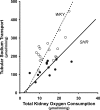Renal oxidative stress, oxygenation, and hypertension
- PMID: 21832206
- PMCID: PMC3213938
- DOI: 10.1152/ajpregu.00720.2010
Renal oxidative stress, oxygenation, and hypertension
Abstract
Hypertension is closely associated with progressive kidney dysfunction, manifested as glomerulosclerosis, interstitial fibrosis, proteinuria, and eventually declining glomerular filtration. The postulated mechanism for development of glomerulosclerosis is barotrauma caused by increased capillary pressure, but the reason for development of interstitial fibrosis and the subsequently reduced kidney function is less clear. However, it has been hypothesized that tissue hypoxia induces fibrogenesis and progressive renal failure. This is very interesting, since recent reports highlight several different mechanisms resulting in altered oxygen handling and availability in the hypertensive kidney. Such mechanisms include decreased renal blood flow due to increased vascular tone induced by ANG II that limits oxygen delivery and increases oxidative stress, resulting in increased mitochondrial oxygen usage, increased oxygen usage for tubular electrolyte transport, and shunting of oxygen from arterial to venous blood in preglomerular vessels. It has been shown in several studies that interventions to prevent oxidative stress and to restore kidney tissue oxygenation prevent progression of kidney dysfunction. Furthermore, inhibition of ANG II activity, by either blocking ANG II type 1 receptors or angiotensin-converting enzyme, or by preventing oxidative stress by administration of antioxidants also results in improved blood pressure control. Therefore, it seems likely that tissue hypoxia in the hypertensive kidney contributes to progression of kidney damage, and perhaps also persistence the high blood pressure.
Figures




References
-
- Adler S, Huang H. Impaired regulation of renal oxygen consumption in spontaneously hypertensive rats. J Am Soc Nephrol 13: 1788–1794, 2002 - PubMed
-
- Adler S, Huang H. Oxidant stress in kidneys of spontaneously hypertensive rats involves both oxidase overexpression and loss of extracellular superoxide dismutase. Am J Physiol Renal Physiol 287: F907–F913, 2004 - PubMed
-
- Aukland K, Krog J. Renal oxygen tension. Nature 188: 671, 1960 - PubMed
-
- Beltowski J. Hypoxia in the renal medulla: implications for hydrogen sulfide signaling. J Pharmacol Exp Ther 334: 358–363, 2010 - PubMed
-
- Bernal-Mizrachi C, Gates AC, Weng S, Imamura T, Knutsen RH, DeSantis P, Coleman T, Townsend RR, Muglia LJ, Semenkovich CF. Vascular respiratory uncoupling increases blood pressure and atherosclerosis. Nature 435: 502–506, 2005 - PubMed
Publication types
MeSH terms
Substances
Grants and funding
LinkOut - more resources
Full Text Sources
Medical
Miscellaneous

